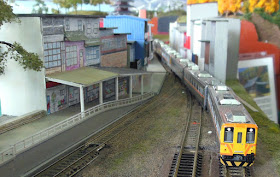Here is an overall view of the AsiaNrail layout taken on Sunday morning before the show opened. This layout was like a 4 point fork with the link to the Hot Springs module being the handle of the fork for a 5th branch.
With no connecting tracks to install the setup and tear down went more quickly. We did have to play around in the beginning keeping the alignment of the rails whenever modules got bumped. It seemed by late Saturday everything had settled in fine and we had no further derailments.
This photo is actually from the Hiller exhibit last spring but shows Paul's junction module which allows for two independent point to point operations or interchange. For this layout one long point to point operation was between my Hot Springs and Mushahi-Koyama modules.
Besides Paul and myself, we had 4 other operators so a total crew of 6 which was just right for this setup.
The public attendance was estimated by the museum to have been about 3,000.
Thanks to Junior Flores and Julia Jackson for letting me use some of their photos.



















































